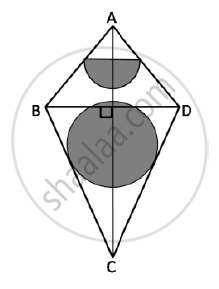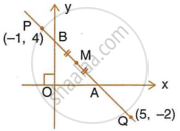Advertisements
Advertisements
Question
In the given figure ABCD is a rectangle. It consists of a circle and two semi-circles each of
which are of radius 5 cm. Find the area of the shaded region. Give your answer correct to
three significant figures

Solution
Length of a rectangle = Radius of two semi-circles Diameter of a circle
= 5 + 5 + 10
= 20 cm
Breadth of a rectangle = Diameter of a circle = 2 x 5 = 10 cm
∴ Area of a rectangle = Length x Breadth
= 20 x 10
= 200 sq. cm
Area of circle = `22/7 xx 5 xx 5` = 78.571 sq.cm
And, area of two semi-circles each of radius 5 cm = `2(1/2 xx 78.571)` = 78.571 sq. cm
Now,
Area of shaded region = Area of a rectangle - Area of a circle - Area of two semi- circle
= 200 - 78.571 - 78.571
= 200 - 157.142
= 42.858 sq.cm
APPEARS IN
RELATED QUESTIONS
The given figure represents a kite with a circular and a semicircular motifs stuck on it.
The radius of a circle is 2.5 cm and the semicircle is 2 cm. If diagonals AC and BD are
of lengths 12 cm and 8 cm respectively, find the area of the:
1) Shaded part. Give your answer correct to the nearest whole number.
2) Unshaded part

Three vertices of parallelogram ABCD taken in order are A(3, 6), B(5, 10) and C(3, 2)
1) the coordinate of the fourth vertex D
2) length of diagonal BD
3) equation of the side AD of the parallelogram ABCD
A straight line passes through the points P(–1, 4) and Q(5, –2). It intersects the co-ordinate axes at points A and B. M is the mid-point of the segment AB. Find:

- The equation of the line.
- The co-ordinates of A and B.
- The co-ordinates of M.
(1, 5) and (–3, –1) are the co-ordinates of vertices A and C respectively of rhombus ABCD. Find the equations of the diagonals AC and BD.
Show that A(3, 2), B(6, −2) and C(2, −5) can be the vertices of a square.
- Find the co-ordinates of its fourth vertex D, if ABCD is a square.
- Without using the co-ordinates of vertex D, find the equation of side AD of the square and also the equation of diagonal BD.
A line through origin meets the line x = 3y + 2 at right angles at point X. Find the co-ordinates of X.
O(0, 0), A(3, 5) and B(−5, −3) are the vertices of triangle OAB. Find the equation of altitude of triangle OAB through vertex B.
A line AB meets the x-axis at point A and y-axis at point B. The point P(−4, −2) divides the line segment AB internally such that AP : PB = 1 : 2. Find:
- the co-ordinates of A and B.
- equation of line through P and perpendicular to AB.
A line is of length 10 units and one end is at the point (2, – 3). If the abscissa of the other end be 10, prove that its ordinate must be 3 or – 9.
